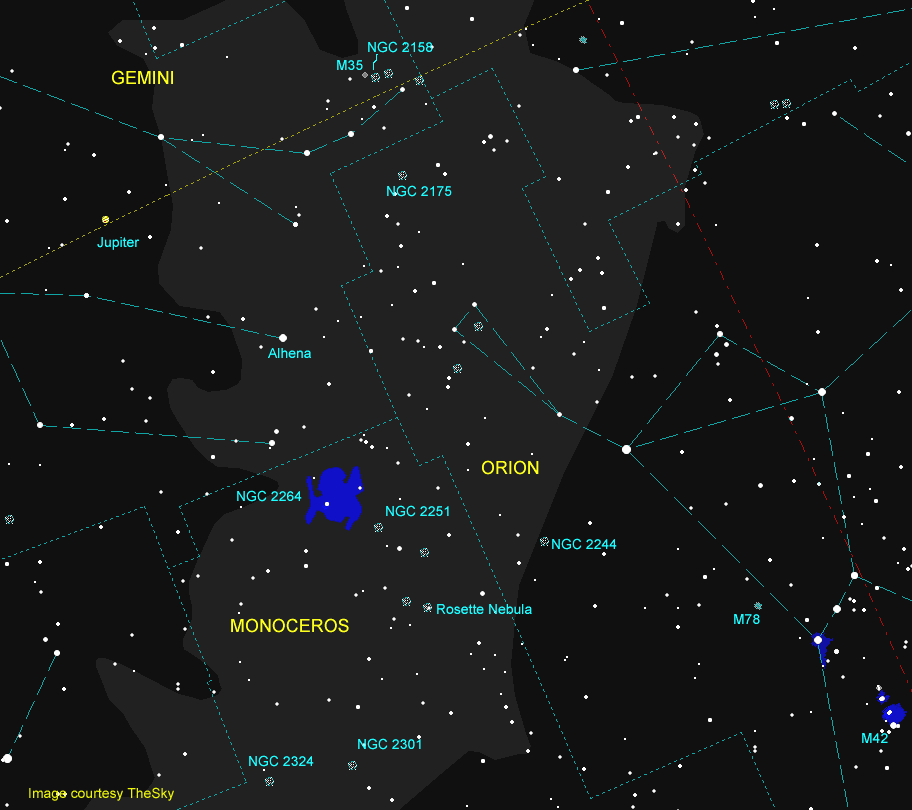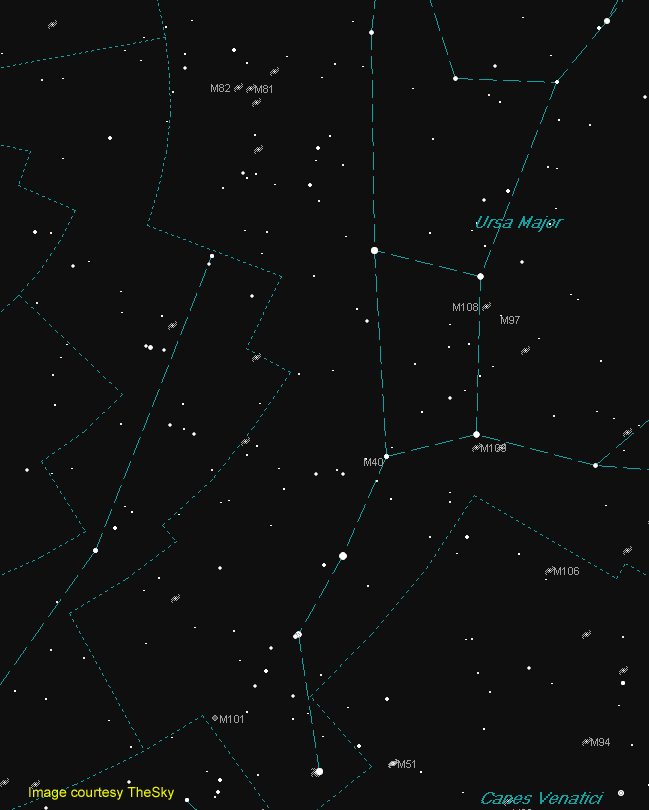The Winter Milky Way, Part 2
Last month we ended our tour of the Winter Milky Way in Auriga with a trio of open clusters namely M38, M36 and M37. Travelling down from this point, we now cross the border and find ourselves in Gemini. The two prominent stars depicting the twins are Castor and Pollux with distances of 52 and 34 light-years respectively. Using simple binoculars, move to the feet of Castor until a magnitude 5.5 open cluster jumps in your field of view.
This is M35 and is located some 2,800 light-years from us. Its angular size is close to that of the Full Moon (30 arc minutes). With a low power telescope, nudge to the west about three-quarters a field of view to a much smaller and fainter cluster. Welcome to NGC 2158. This remote open cluster thought to be a billion years old, glows at magnitude 8.6 and is four times farther than M35.

While still in Gemini be sure to pay good ole Jupiter a visit. The king of planets is located perfectly between the twins. When we look at those dazzling dots in the sky, we can not imagine how large these balls of gas can actually be. Case in point the star Alhena located at the foot of Pollux. At first glance, it looks like any other star but Alhena has a radius five times that of our Sun and 160 times brighter.
Let’s take a short break from the Milky Way with a slight detour to a lovely planetary nebula. From M35, move your scope to the star called Wasat which is a class F subgiant star located 59 light-years from us and has a companion. Astronomers estimate this star to be 100 astronomical units from Wasat and take about 1,200 years to orbit once around the primary. Now keep moving past this sun until you come across a bluish-green fuzz. Here we have the Eskimo Nebula – NGC 2392. The complex structure is a result of the dying central star.
Continuing the tour from M35, we descend down to the large Rosette Nebula. This large circular region of hydrogen known as Caldwell 49 is located some 5,200 light-years away and about 130 light-years in width. A nice open cluster showing three pairs of stars is NGC 2244 is located at the center and was created from this enormous star-making cloud. Radiation from these young stars is exciting the nebula’s atoms thus making it glow. This nebula holds enough gas and dust to produce 10,000 solar masses. Star production still ongoing.

Our next target is M50 located a little more than 15 degrees south of the Rosette. At magnitude 5.9 this rich open cluster is just on the edge of naked-eye visibility. It resides about 3,200 light-years away and holds about 200 stars. However, along the way to M50, you will pass a half a dozen other open clusters. As we cross over to the constellation of Canis Major we come across the brightest star in the Northern Hemisphere – Sirius. Commonly known as the Dog Star, Sirius is only 8.6 light-years from us. This main sequence star shines at magnitude minus 1.46. Sirius has a very close magnitude 8.44 companion star that is extremely hard to see. Sirius B is a dwarf star and smaller than planet earth in size. It orbits Sirius in about 50 years in a very elliptical orbit, bringing it as close as 8 AU and as far as 31 AU.
Now from Sirius move 4 degrees south to M41. AKA the Little Beehive is a finely sprinkled collection of about 100 stars. It is 2,300 light-years away and about 25 light-years wide. Astronomers estimate this cluster to be about 190 million years old. Its angular size is larger than the full moon.
Our final target is M46. At first glance, it seems to be your typical rich open cluster but with a twist but embedded is the planetary nebula NGC 2438. This nebula is not a true member of M46 but appears as a line of sight object only. As a stark contrast in distance, M46 is about 5,400 light-years away as opposed to the 2,900 light-years for the nebula. M46 lies thirteen degrees east of Sirius
But of course, we save the best for last. M42 is a must on every clear night. At only 1,500 light-years from us, this emission nebula spans some 42 light-years in width. This stellar nursery will eventually produce hundreds of stars from pockets of interstellar dust and gas called Evaporating Gaseous Globules of EGGs.

Let us turn our scopes to the far north to see and most explosive event Mother Nature can dish out – a supernova. The galaxy M82 is not called the Starburst Galaxy for anything. Supernova 2014j was discovered on the night of January 21 by Steve Fossey and four undergrad students at the University of London Observatory. This event is a Type 1a supernova of a dwarf star. The debris from this explosion was hurling through space at 20,000 km/sec. I said ‘was’ as this actually occurred 12 million years ago. It took that long for the light to reach us. Astronomers believe the supernova will keep brightening for about two weeks or sometime during the first week of February. A moderate telescope of a good pair of binoculars will show the supernova. And yet another supernova was confirmed in M99. This, however, will be a challenge to spot at magnitude 15.7.
Venus has now crossed over to the morning side of the Sun. At 6 a.m. local time the planet is a few degrees above the horizon. If you have never seen the phase structure when Venus was sinking in the western sky a few weeks ago, you now have the opportunity to catch the thin phase before you head to work or school. Jupiter still remains the beacon of the night and is located smack in the middle of the constellation Gemini. For times of satellite transits and shadows, refer to pages 231-232 of the RASC Observers Handbook 2014. Since Jupiter is now past opposition, it appears higher up the eastern horizon at dusk and remains out till it sets at 4 a.m. local time.

Uranus is a small and featureless planet. The 21 percent waxing crescent Moon will help guide you to the seventh planet of our solar system. The fuzzy bluish-green dot is located about two degrees to the bottom left of the Moon on Feb 3. For those with automated telescopes and a CCD camera, you can photograph the satellites since they are too faint to see with your eye as Titania, Ariel, Umbriel, Oberon and Miranda range from magnitude 14.1 to 16.6. Uranus is presently 3.08 billion kilometres or more than 20 AU from us. Its light takes 2 hours and 52 minutes to reach us.
This month’s Full Snow Moon occurs on Feb 14 and because of the short month; we do not have a new Moon. However, lunation 1128 begins on the first of March. For those that live in dark areas, you can begin to look for the zodiacal light in the western sky about an hour after sunset. Start looking a few days after full Moon.
Until next month, clear skies everyone.
